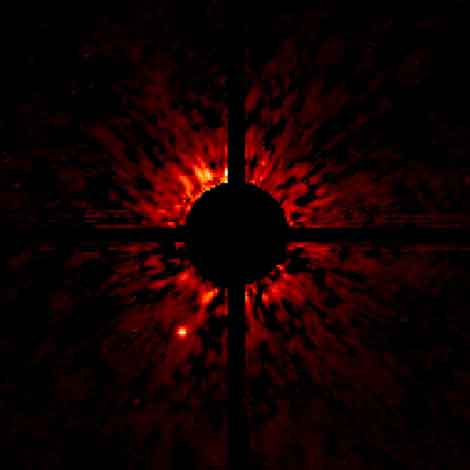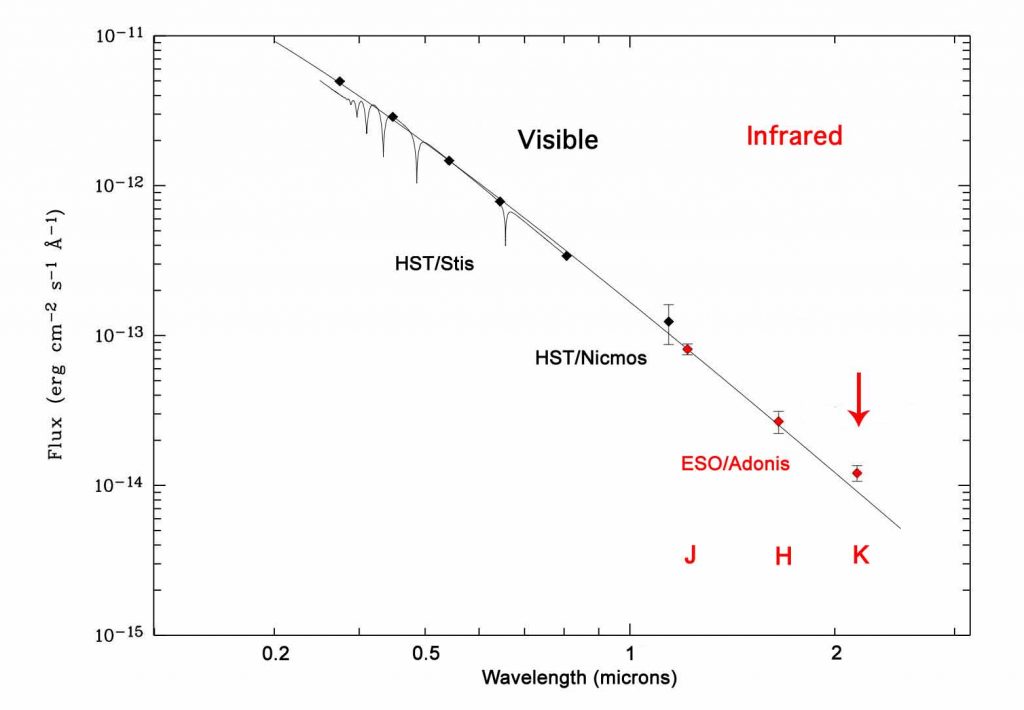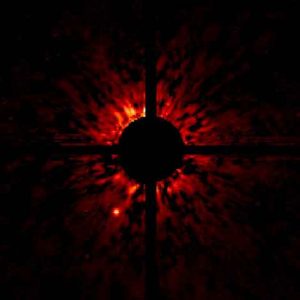No planets around Sirius ?
Sirius, the brightest star of the sky, is reported to have shown a change of colour, a possibility that has led some scientists to suspect a possible but yet undetected small companion.
Now using a specific mask and the modern technique of adaptive optics which allows to suppress most of the blurring of the atmosphere, Jean-Marc Bonnet-Bidaud and Eric Pantin of the C.E.A. Astrophysical Department have obtained the first and most sensitive image of the Sirius field, in the infrared domain. It is in this energy range that the smallest stars and even planets can be most easily detected.
The new image, despite its high spatial resolution (0,2 arcsecond) and superior contrast, does not reveal any other companion than the already known white dwarf Sirius-B. The limiting mass is that of a massive planet so that at least no big planets orbit Sirius.
The image also provides the first measurements of Sirius-B infrared fluxes and yields some surprise. It reveals a possible small infrared excess that may indicate the existence of circumstellar material around the white dwarf. Though still to be confirmed by further observations this may show that if planets exist around Sirius, it could be only planetary debris around Sirius-B, as already observed around other white dwarfs.
The results are published in the October issue of the Astronomy and Astrophysics Journal.
| Images |
|
Podcast J.M. Bonnet-Bidaud with Ciel&Espace Radio (in french) |
Video-Animation (fichier MOV 4.3 Mo) |

The colour enigma and the third body hypothesis
Sirius is a double star with a heavy dense star, a white dwarf called Sirius-B, orbiting the bright star, Sirius-A, in about 50 years [1]. According to different historical texts, the Sirius system may have changed colour about 2000 years ago (see “The Sirius colour enigma“). This has led to the hypothesis of a third member in the Sirius system, a small but yet undetected companion orbiting Sirius-A in a very long (> 2500 year) and elongated orbit.
The deepest infrared image.
To efficiently search for a small object around Sirius-A, the scientists of the C.E.A. Astrophysical Department have used a powerful technique called “adaptive optics” that corrects in real time the disturbance of the atmosphere and reduces considerably the diffusion of light. A mask was also used to suppress the strong light from Sirius-A and the image was obtained in the infrared range where the small objects are most easily seen [2].
The resulting image obtained is the “cleanest” one ever obtained of the Sirius system. It clearly reveals the small white dwarf companion, Sirius-B, at a separation of 5 arcsec. Though most of the light of Sirius-A (hidden behind the mask) is already suppressed, some diffuse light is still present. A very precise and powerful analysis had to be applied to compute the maximum mass of an object to be visible in the image.
“It’s a hard task, like looking for a needle in a haystack” comments Jean-Marc Bonnet-Bidaud. “Previous attempts were made in the optical, including observations with the Hubble Space telescope but the infrared is the most powerful tool as the small stars emit most of their light in this range”
This infrared image reveals that no other object is detected with a maximum mass ranging from 30 Mjup (Mjup is the mass of the Jupiter planet) at a distance of 8 A.U. (slightly smaller than the Sun-Saturn distance) to 10 Mjup at a distance of 26 A.U. (slightly smaller than the Sun-Neptune distance). The A.U. (Astronomical Unit) is the Earth-Sun distance.
These new precise limits on small objects in orbit around Sirius probably definitively rules out the hypothesis of a third star in the Sirius system. Since the most central part of the image (at distance less of 5 AU) is still not covered, the only possibility is that the third star is in this very unfavourable position but the probability of a triple system is now low.

Destroyed planets around Sirius-B ?
With this image, the scientists have also been able to measure the infrared flux of the white dwarf companion, Sirius-B, for the first time. As the white dwarf mass and radius are well determined, this infrared flux could be accurately compared with the expectations from the theoretical models.
The measurements were done at three different infrared wavelengths of 1.2 (J), 1.6 (H) and 2,2 (K) microns that can be considered as infrared “colours”. Two colours were found to match nearly perfectly the theoretical prediction but the third one showed an unexpected difference. An small but significant excess of light is seen at longer wavelength K(2.2 microns), comparable to what observed in some other isolated white dwarfs.
From a survey by the Spitzer Infrared satellite, in orbit since 2003, more than 120 white dwarfs have indeed been accurately measured in the infrared and four have a small excess starting at 2.2 microns. Usually the infrared excess increases greatly at longer wavelengths. Such large amount of infrared flux is the signature of significant dust surrounding the white dwarf. In several cases, it is heavily suspected that this dust may come from destroyed planets that once were orbiting the dense star. It is the same around Sirius-B? Were there once planets around Sirius-B now destroyed into dust ? Is this event related to the colour change ?
More observations of Sirius-B are now planned at longer wavelengths to try to confirm the hypothesis. Sirius may once again puzzle the astronomers.

Contact : J.M. Bonnet-Bidaud
“ADONIS high contrast infrared imaging of Sirius-B“
J.M. Bonnet-Bidaud, E. Pantin
published in Astronomy & Astrophysics, vol. 489, p. 651-655, octobre 2008
For an electronic version (format PDF, 541 Ko)
see also : – “L'affaire Sirius”, revue Ciel et Espace
: – Film ARTE (video)
|
“L'optique adaptative” ARTE/Archimède
Extract from a video realized during observations (in french) |
and “Enigmes de Sirius”, Film CNRS 2009
“L'énigme Sirius”, podcast Ciel & Espace, 6 oct. 2008
Notes
[1] Sirius-B was discovered visually in 1862 as a faint star (mv=8) close to Sirius-A by Alvan Clark using a 18,5 inch refractor. Its existence was predicted much earlier in 1844 by the mathematician Friedrich Bessell who induced its mass from the small disturbance it produces in the movement of Sirius-A. Its orbit has now been monitored accurately revealing an orbital period of 50,05 years. Sirius-B is a white dwarf, a dense object resulting from the core collapse of a star at the end of its life. It has a mass nearly equal to the Sun (1,03 Mo), but a radius of only 5700 km compared to 700 000 km for the Sun.
[2] The observations were done using the ADONIS instrument at the focus of the 3.6 m telescope of the European Southern Observatory at La Silla (Chile) at the wavelengths of 1.2, 1.6 and 2.2 microns.
Rédaction: J.M. Bonnet-Bidaud



